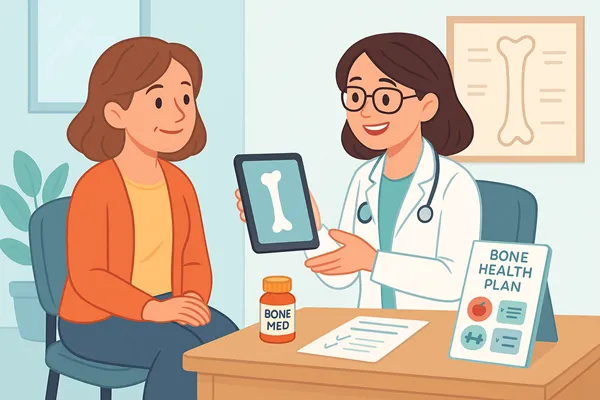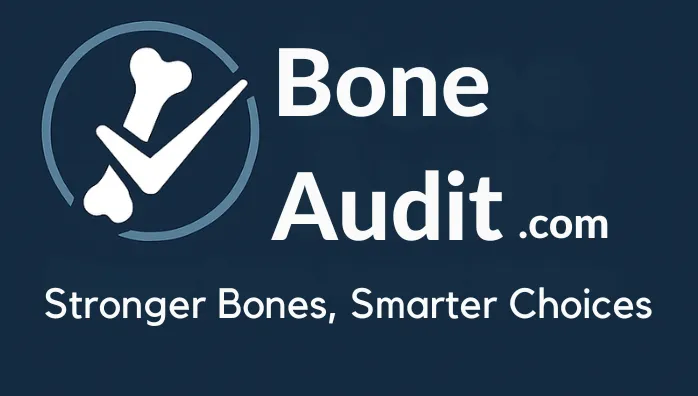
Feeling Unsure About Bone Medications? Here's What You Should Know.
If you've been diagnosed with osteopenia or osteoporosis, your doctor may have recommended bone medication fairly quickly. That can feel confronting — especially if you’ve heard about potential side effects.
This article will help you understand:
Why bone medications are often prescribed
What the two main types are and how they work
The side effects people are most concerned about
And how to think about your options with confidence, not fear
Why Bone Medications Are Often the First Recommendation
When you’re diagnosed with osteoporosis — especially with a low T-score or history of fractures — it’s common for doctors to suggest medication straight away.
This follows clinical guidelines and is often seen as a way to reduce fracture risk quickly.
Doctors are trained to follow this protocol and may not always have time or training to explore a broader plan that includes nutrition, hormonal health, or lifestyle strategies. That doesn’t mean they’re wrong — just that their advice is based on the most widely accepted medical pathway.
That’s why it’s helpful to understand how these medications work and how they can fit (or not) into your personal plan.
The Two Main Types of Bone Medications
Bone medications fall into two main categories:
1. Bisphosphonates (e.g. Fosamax, Actonel, Aclasta, Prolia)
These slow down the activity of osteoclasts, which are the cells that break down bone.
By reducing the rate of bone loss, they can help stabilize or increase bone density.
2. Anabolic Medications (e.g. Evenity, Forteo, Tymlos)
These stimulate osteoblasts, the cells that build new bone.
They are usually reserved for people with very low bone density or multiple fractures, and are typically used in time-limited courses (e.g. 12–24 months).
Common Side Effects of Bisphosphonates
Most people tolerate bisphosphonates well, especially in the short term. But like any medication, there are risks to be aware of — particularly with long-term use.
🔹 Atypical Femur Fractures
These are stress fractures that occur in the femur (thigh bone) — the strongest bone in the body.
They’re called “atypical” because it’s unusual to see a fracture there without trauma, such as a fall. These fractures tend to happen in people who have taken bisphosphonates for many years and may be related to bone becoming too brittle over time.
🔹 Osteonecrosis of the Jaw (ONJ)
ONJ is a rare condition where a portion of the jawbone becomes exposed and doesn’t heal.
It’s often associated with dental work and long-term medication use. The clinical definition typically involves exposed jawbone that has not healed within 8 weeks, usually following a tooth extraction or other invasive dental procedure.
Good dental care and communication with your dentist can help reduce the risk.
What You Should Know About Prolia
Prolia (denosumab) is a widely used injectable medication in the bisphosphonate category.
It works well to reduce bone loss while you’re on it — but if stopped suddenly without a follow-up plan, it can lead to a sharp increase in bone breakdown, raising the risk of rebound fractures, particularly in the spine.
If you choose to start Prolia, make sure your doctor discusses an exit plan in advance — usually involving a follow-on medication to help avoid this issue.
Known Side Effects of Anabolic Drugs
Anabolic medications are generally well tolerated. However, possible side effects include:
Leg cramps or muscle aches
Dizziness
Temporary increase in blood calcium
Mild irritation at the injection site
These medications are typically given for a short period and often followed by a bisphosphonate to help maintain gains in bone density.
Are These Side Effects Common?
Not typically. Most side effects — especially the more serious ones — tend to appear only after long-term or improper use, or when stopping medications like Prolia without a follow-up plan.
When used carefully and for a limited time, bone medications can offer a safe and effective window for stabilizing your bones.
What Are Your Options?
There is no one-size-fits-all answer — and that’s okay. Here are two common approaches:
🔸 Option 1: Use Medication to Stabilize While You Work on Underlying Causes
If your T-score is very low or you’ve already had a fracture, starting medication might be appropriate.
At the same time, you can begin working on the underlying drivers of bone loss — like nutrition, hormones, sleep, or inflammation — using tools like the Bone Health Check-In.
Think of this like a “kitchen sink” strategy: do everything you can to create change, then re-evaluate.
🔸 Option 2: Hold Off on Medication and Reassess Later
If you feel unsure, you may decide to work on lifestyle and health changes first — then repeat your DEXA or Echolight scan in 12–24 months.
If your bone density improves or remains stable, you might not need medication at all.
If it declines further, that may be the time to reconsider options — with better information and a clearer plan.
Final Thought
It's natural to feel nervous after reading about side effects. But remember — these medications are tools, and tools are most powerful when used with care and context.
The best decision is one made from good information, not fear. Take time to learn. Ask questions. And choose a path that matches both your values and your current health needs.
You’re in charge of this journey — and support is here when you need it.
